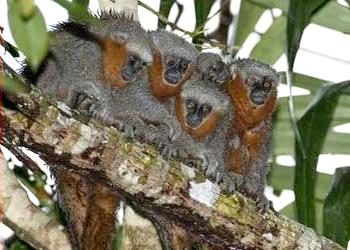
SAO PAULO, Brazil, March 4, 2015 (ENS) – A bright orange tail and ocher sideburns distinguish a newly found species of Brazilian monkey from its closest relatives. Its existence threatened before scientists even get to know it, the new monkey inhabits a small area of lowland rainforest subject to deforestation and development.
Scientists found the new species of titi monkey in the central-southern area of the Brazilian Amazon, according to their study published in “Papéis Avulsos de Zoologia,” a peer-reviewed scientific journal published by the Museum of Zoology of the University of São Paulo.

nov. in the forest at Panelas on the bank of the Roosevelt river, northwestern Mato Grosso, Brazil (Photo by A. Gambarini)
The new monkey is in the genus Callicebus, one of the most diverse Neotropical primate groups, with 31 recognized species.
Gaps in scientific knowledge about this genus are gradually being filled due to recent intensification of sampling efforts. Several geographic distributions have recently been better mapped, and six new species have been described in the last 15 years, say the study’s three authors – all Brazilian scientists.
Titis of the genus Callicebus inhabit forests across South America. They have long, soft fur and live in small family groups consisting of a monogamous pair and their offspring. They are often seen sitting or sleeping with their tails intertwined.
The new species differs from all other Amazonian Callicebus by an exclusive combination of the light gray line of the forehead, dark ocher sideburns and throat, dark gray portions of the torso and flanks, and orange tail.
Based on these characteristics, the scientists formally described the monkey as a new species, which they named Callicebus miltoni, or Milton’s titi monkey, in honor of Dr. Milton Thiago de Mello, a Brazilian primate expert, who has trained many of the country’s primate specialists.
The new species is located in an area of lowland rainforest between the Roosevelt and Aripuanã rivers and south of the Amazon River, in the states of Mato Grosso and Amazonas.
Roughly 25 percent of the area inhabited by C. miltoni lies within conservation areas; in addition about 32 percent of their habitat is located within indigenous lands. So, in total, 57 percent (2,801 hectares) of their habitat lies within protected areas.

Martin Fowlie of BirdLife International in Cambridge, England explains how the discovery occurred. “In 2011, researcher Julio César Dalponte spotted an unusual looking titi monkey on the east bank of the Roosevelt River, whose coloration did not match any known species. Intrigued, a team of scientists supported by the Conservation Leadership Programme headed back into the field to collect the information needed to formally describe what they believed to be a new species.”
The Conservation Leadership Programme is a partnership between BirdLife International, Fauna & Flora International and the Wildlife Conservation Society that promotes the professional development of conservationists.
“It goes without saying that we are really excited about this new discovery,” said researcher Felipe Ennes Silva, who collected the data for the new species description.
“It is always thrilling to find something new in the Amazon, as it reminds us just how special this rainforest is and how lucky we are to have it on our doorstep,” he said.
“But it will take more than luck if we are to keep making scientific finds like this. The rainforest is under threat like never before, and it will take dedicated, hard work – not just by conservationists but by the government and every other sector of society too – to make sure that this forest ecosystem can continue to support a wide diversity of life and help regulate our planet’s climate,” said Ennes.
“Data collection in the field was conducted by walking on pre-existing trails, and in canoes on the banks of the Guariba River, near the Aripuanã River,” the authors write in their study. “We collected data using a combination of direct observations, collection of specimens and interviews with local residents.”
The scientists played recordings of the vocalizations of another species of titi monkey to locate C. miltoni by their responses.
This species is not able to swim or cross mountainous terrain, which means that it is restricted to a small area bounded by rivers and hills.
Deforestation rates are high there, with forest fires posing an additional threat, Fowlie explains. In addition, he points out, the Brazilian government is developing several new hydroelectricity dams and an extension of the road system in the region.
Copyright Environment News Service (ENS) 2015. All rights reserved.
© 2015, Environment News Service. All rights reserved. Content may be quoted only with proper attribution and a direct link to the original article. Full reproduction is prohibited.
